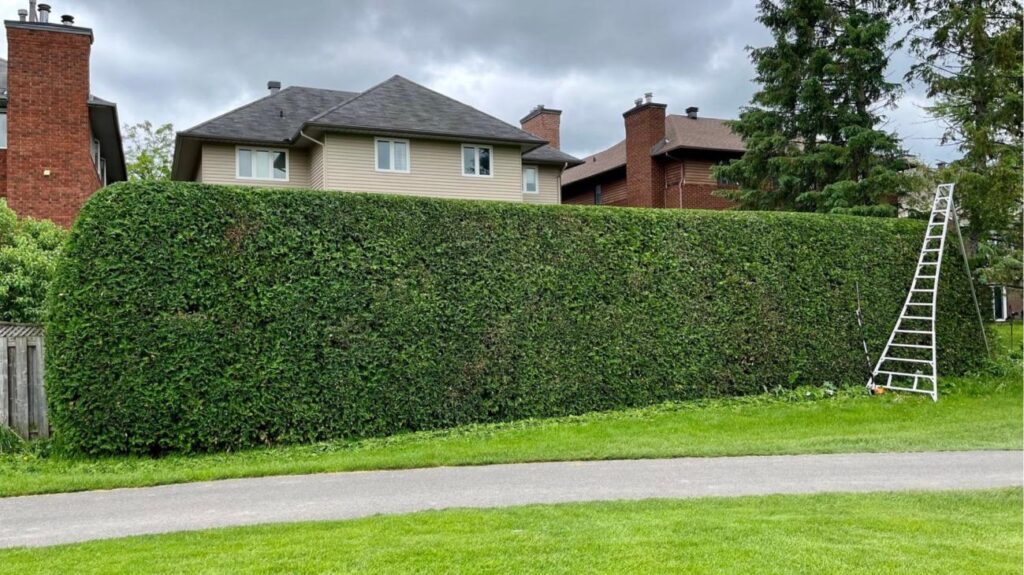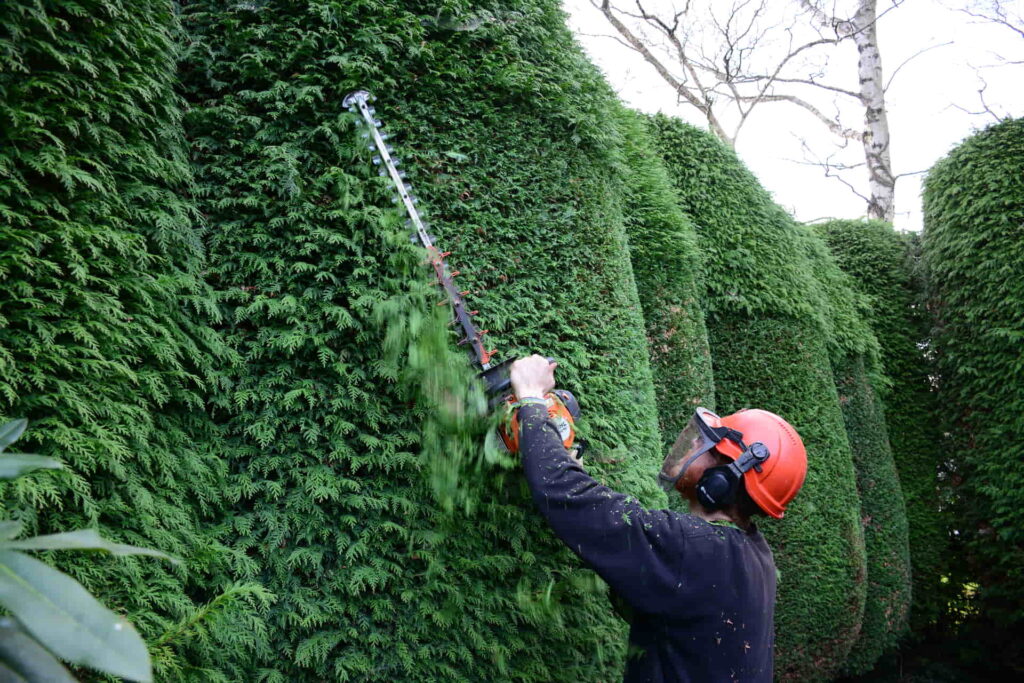Hedges are not just functional elements in a landscape; they can also add beauty and character to outdoor spaces. Hedge shaping is an art that requires careful planning and skillful execution to create stunning landscapes. In this article, we will explore the basics of hedge shaping, the tools you need to get started, selecting the right hedge for your landscape, planning your hedge design, techniques for shaping hedges, and the maintenance and care required to keep your hedges looking their best.
Understanding the Basics of Hedge Shaping
Before you dive into hedge shaping, it’s important to understand the fundamental principles behind this art form. Hedge shaping involves sculpting hedges into specific shapes and forms, ranging from geometric patterns to more organic designs. It requires an eye for detail and a good understanding of plant growth habits and pruning techniques.
Hedge shaping is both an art and a science. To create aesthetically pleasing designs, you need to consider factors such as symmetry, proportion, and balance. At the same time, you must be aware of how the plants will respond to pruning and shaping, ensuring their health and longevity.
The Art and Science of Hedge Shaping
Hedge shaping is a delicate balance between artistic vision and scientific knowledge. It involves using pruning techniques to manipulate the growth of the hedge plants, creating shapes and forms that complement the surrounding landscape. When done right, hedge shaping can transform a dull space into a visually striking masterpiece.
Artistic vision plays a crucial role in hedge shaping. It allows you to envision the final result and determine the best way to achieve it. Whether you prefer clean, crisp lines or more organic, flowing shapes, your artistic choices will define the overall aesthetic of the hedge.
On the other hand, scientific knowledge is equally important. Understanding how plants grow and respond to pruning is essential for successful hedge shaping. By knowing the growth habits of different hedge species, you can strategically prune and shape them to achieve the desired effect. This knowledge also helps you maintain the health and vitality of the plants, ensuring they thrive for years to come.
See Also: Why Tree Pruning Sydney is Essential for Tree Health
Essential Tools for Hedge Shaping
To achieve professional results in hedge shaping, you need to have the right tools at your disposal. Some essential tools include hedge trimmers, hand pruners, loppers, pruning saws, and protective gear. These tools will enable you to shape hedges with precision and efficiency. It’s important to invest in high-quality tools to ensure accuracy and minimize damage to the plants.
When selecting hedge trimmers, consider the size and weight of the tool, as well as its cutting capacity. Hand pruners are ideal for detailed work and shaping smaller branches, while loppers are better suited for thicker branches. Pruning saws come in handy for larger branches that require more substantial cuts. And don’t forget to protect yourself with gloves, safety glasses, and ear protection, especially when working with power tools.

Selecting the Right Hedge for Your Landscape
Choosing the right hedge for your landscape is crucial for successful hedge shaping. Consider factors such as climate, soil conditions, desired height and width, and aesthetic preferences. Popular hedge plant options include boxwood, privet, yew, and arborvitae. Research different hedge species and their growth habits to find the one that suits your needs best.
Each hedge species has its own unique characteristics and requirements. Some are more tolerant of different soil conditions, while others thrive in specific climates. Consider the maintenance needs of each species as well, as some hedges may require more frequent pruning and shaping than others. By selecting the right hedge for your landscape, you set yourself up for a successful hedge shaping journey. You can visit https://education.nationalgeographic.org/resource/hedging-biodiversity to get more about hedges of biodiversity.
Planning Your Hedge Design
Before you start shaping your hedges, take the time to plan your design. This will help you visualize the end result and ensure that your hedge fits harmoniously into the overall landscape. Consider the principles of landscape design, such as unity, balance, and focal points, when creating your hedge layout.
Creating a hedge is not just about trimming shrubs into a neat shape; it is an art form that requires careful thought and consideration. By incorporating the principles of landscape design, you can elevate your hedge from a simple green barrier to a stunning focal point in your outdoor space.
Principles of Landscape Design
Landscape design principles can guide you in creating a cohesive and visually appealing hedge design. Unity refers to creating a sense of harmony and cohesion between different elements in the landscape. When planning your hedge layout, think about how it will complement the existing features of your outdoor space. Will it enhance the architectural structures or blend seamlessly with the natural elements?
Balance is another important principle to keep in mind. You can achieve balance through symmetrical or asymmetrical designs, depending on the desired effect. A symmetrical hedge layout can create a formal and structured look, while an asymmetrical design can add a touch of whimsy and playfulness to your landscape.
Focal points are essential for drawing attention and creating visual interest. Consider incorporating a unique plant species or adding decorative elements, such as sculptures or colorful flowers, to make your hedge stand out. By strategically placing focal points within your hedge layout, you can create a captivating and dynamic outdoor space.
Creating a Hedge Layout
When creating your hedge layout, consider the existing features of your landscape, such as walkways, architectural structures, and natural elements. These elements can serve as a guide for determining the placement and shape of your hedges. For example, if you have a curved pathway, you can complement it by shaping your hedges in a flowing, organic manner.
It is also important to think about the growth habits of the selected plant species. Some shrubs grow tall and narrow, while others spread out and fill space. Understanding the growth patterns of your chosen plants will help you determine the desired height, width, and shape of your hedge. By considering these factors, you can ensure that your hedge will not only look beautiful when first planted but will also maintain its shape and form as it grows over time.
Sketching out your design on paper or using landscaping software can be a helpful tool for visualizing the placement of your hedges. This allows you to experiment with different layouts and make adjustments before committing to the final design. Remember, creating a hedge layout is a creative process, so don’t be afraid to explore different options and let your imagination run wild!
Incorporating Hedges into Existing Landscapes
If you already have an established landscape, incorporating hedges can add depth and structure to the design. By carefully selecting the right plant species and considering the existing elements, you can seamlessly integrate hedges into your outdoor space.
When incorporating hedges into an existing landscape, it is important to consider the color and texture of the hedge foliage. By choosing plants with foliage that complements the surrounding plants, you can create a harmonious composition that enhances the overall aesthetic of your outdoor space. For example, if you have vibrant flowers in your garden, consider selecting a hedge with foliage that provides a contrasting backdrop, allowing the flowers to truly shine.
Remember, the key to successfully incorporating hedges into an existing landscape is to create a sense of unity and balance. By carefully considering the existing features, selecting the right plant species, and paying attention to the details, you can create a hedge design that seamlessly integrates with your outdoor space and adds a touch of elegance and sophistication.

Techniques for Hedge Shaping
Now that you have planned your hedge design, it’s time to put your shaping skills to work. There are various techniques you can use to shape your hedges, from basic trimming to more advanced shaping methods.
Before diving into the shaping process, it’s essential to consider the type of hedge you are working with. Different hedge species may require specific pruning techniques to thrive. For example, formal hedges like boxwoods are often sheared to maintain a neat appearance, while informal hedges like privet may benefit from a more natural, layered pruning approach.
Basic Hedge Shaping Techniques
Basic hedge shaping techniques include regular trimming to maintain the desired shape and size of the hedge. This involves using hedge trimmers to remove excessive growth and create clean lines. Additionally, thinning out the interior foliage can improve air circulation and promote healthy growth.
When trimming your hedges, it’s crucial to use sharp and clean tools to prevent damage and ensure a precise cut. Avoid pruning during the hottest part of the day to reduce stress on the plants, and always step back periodically to assess your progress and make adjustments as needed.
Advanced Shaping Techniques for Unique Designs
If you want to go beyond basic trimming, advanced shaping techniques can help you create unique designs. Topiary is a technique that involves sculpting hedges into intricate shapes, such as animals or geometric patterns. Espalier is another technique where hedges are trained to grow flat against a wall or trellis, adding a decorative element to the landscape. These advanced techniques require patience and precision but can result in stunning visual effects.
Before attempting advanced shaping techniques, it’s advisable to research specific methods for the design you have in mind. Some intricate shapes may require the use of specialized topiary frames to guide the growth of the hedge accurately. Remember that shaping hedges is a form of artistry that allows you to express your creativity in the landscape, so don’t be afraid to experiment and refine your skills over time.
Maintenance and Care for Your Hedge
To ensure that your hedges remain healthy and attractive, regular maintenance and care are essential.
Regular Trimming and Pruning
Regular trimming and pruning are key to maintaining the shape and health of your hedge. Trim your hedges at least once or twice a year, depending on the growth rate of the plant species. Remove any dead or diseased branches to prevent the spread of pests or diseases. Pay attention to the specific pruning needs of your chosen hedge species to ensure optimal growth and flowering.
Pest Control and Disease Prevention
Hedges are susceptible to pests and diseases, which can affect their appearance and overall health. Monitor your hedges regularly for signs of infestation or disease, such as discoloration, leaf damage, or unusual growth. Implement preventive measures, such as regular inspections, proper watering, and appropriate use of fertilizers, to minimize the risk of pests and diseases.
Seasonal Care for Hedges
Different seasons require different care for hedges. In spring, fertilize your hedges to promote healthy growth. Summer months may require more frequent watering to combat dry spells. In fall, remove fallen leaves and debris from the base of your hedges to prevent fungal diseases. Winter care may involve providing extra protection against harsh weather conditions, such as wrapping the hedges with burlap.
By following these guidelines for hedge shaping, you can create beautiful and functional landscapes that enhance the overall beauty and value of your property. With proper planning, execution, and maintenance, your hedges will thrive and become a centerpiece of your outdoor space. So, roll up your sleeves, grab your tools, and let your creativity flourish as you shape your hedges into masterpieces.
More to read: The Ultimate Guide to Modular Sofas for Every Home
